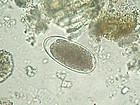Difference between revisions of "Trichostrongyloidea"
Jump to navigation
Jump to search
(Redirected page to Category:Trichostrongyloidea) |
|||
| (5 intermediate revisions by the same user not shown) | |||
| Line 1: | Line 1: | ||
| + | {{unfinished}} | ||
| − | # | + | {{toplink |
| + | |backcolour = | ||
| + | |linkpage =Parasites | ||
| + | |linktext =PARASITES | ||
| + | |pagetype=Bugs | ||
| + | |sublink1=Nematodes | ||
| + | |subtext1=NEMATODES | ||
| + | }} | ||
| + | <br> | ||
| + | == General Appearance == | ||
| + | [[Image:Trichostrongylus.jpg|thumb|right|150px|''Trichostrongylus'' - Joaquim Castellà Veterinary Parasitology Universitat Autònoma de Barcelona]] | ||
| + | *Bursate | ||
| + | *Most members of this superfamily look like short lengths of cotton (typically 0.5-2cm) | ||
| + | *The spicules of each species have a characteristic shape | ||
| + | *The heads have no distinct features | ||
| + | |||
| + | == General Life-Cycle == | ||
| + | *The egg is approximately 80µm long, oval, thin-shelled, contains 4-16cells (i.e. it is a typical strongyle egg) | ||
| + | *Egg → L1 → L2 → L3 (this occurs on the ground) | ||
| + | *L1 and L2 feed on bacteria | ||
| + | *L3 is the infective stage | ||
| + | *L3 is ensheathed (i.e. the L2 cuticle is retained after moulting as an "outer skin") | ||
| + | *L3 cannot feed, but contains a finite amount of stored food to provide energy for movement | ||
| + | *Infection is by ingestion of the L3 | ||
| + | *L3 → L4 → adult (this occurs in the stomach or small intestine) | ||
| + | *Parasitic development initially occurs in gastric glands or intestinal crypts (depending on species) | ||
| + | *Adults are situated on the mucosal surface | ||
| + | *The prepatent period is typically about 3 weeks | ||
| + | |||
| + | [[Nematodirus]] | ||
| + | |||
| + | *''Dictyocaulus viviparus'' causes [[Respiratory Parasitic Infections - Pathology#Dictyocaulus viviparus|parasitic bronchitis]] | ||
| + | *''Dictyocaulus arnfieldi'' causes [[Respiratory Parasitic Infections - Pathology#Dictyocaulus arnfieldi|cough in horses]] | ||
Revision as of 12:22, 9 January 2009
| This article is still under construction. |
|
|
General Appearance
- Bursate
- Most members of this superfamily look like short lengths of cotton (typically 0.5-2cm)
- The spicules of each species have a characteristic shape
- The heads have no distinct features
General Life-Cycle
- The egg is approximately 80µm long, oval, thin-shelled, contains 4-16cells (i.e. it is a typical strongyle egg)
- Egg → L1 → L2 → L3 (this occurs on the ground)
- L1 and L2 feed on bacteria
- L3 is the infective stage
- L3 is ensheathed (i.e. the L2 cuticle is retained after moulting as an "outer skin")
- L3 cannot feed, but contains a finite amount of stored food to provide energy for movement
- Infection is by ingestion of the L3
- L3 → L4 → adult (this occurs in the stomach or small intestine)
- Parasitic development initially occurs in gastric glands or intestinal crypts (depending on species)
- Adults are situated on the mucosal surface
- The prepatent period is typically about 3 weeks
- Dictyocaulus viviparus causes parasitic bronchitis
- Dictyocaulus arnfieldi causes cough in horses
